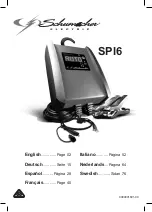
19. Do not use charger while you are tired or under
the influence of drugs, alcohol or medication. A
moment of inattention while operating charger
may result in serious personal injury.
20. Before moving charger, disconnect power supply
and battery, then allow charger to cool.
21. Charger should be grounded to reduce electric
shock. Charger cord is equipped with equipment
grounding conductor and grounding plug.
22. Never alter the AC cord or plug. Improper
connection can result in electric shock.
23. Connect battery charger directly to grounding
receptacle. An adapter should not be used.
24. People with pacemakers should consult their
physician(s) before use. Electromagnetic fields in
close proximity to heart pacemaker could cause
pacemaker interference or pacemaker failure.
In addition, people with pacemakers should:
a. Properly maintain and inspect to avoid
electrical shock.
b. Properly ground power cord. GFCI should also be
implemented to prevent sustained electrical shock.
25. The warnings, precautions, and instructions
discussed in this instruction manual cannot cover all
possible conditions and situations that may occur. It
must be understood by the operator that common sense
and caution are factors which cannot be built into this
product, but must be supplied by the operator.
OPERATION INSTRUCTIONS
PREPARING TO CHARGE
1. If necessary to remove battery from vehicle to
charge, always remove grounded terminal from battery
first. Make sure all accessories in the vehicle are off,
so as not to cause an arc.
2. Be sure area around battery is well ventilated while
battery is being charged.
3. Clean battery terminals. Be careful to keep corrosion
from coming in contact with eyes.
4. Add distilled water in each cell until battery acid
reaches level specified by battery manufacturer. Do
not overfill. For a battery without removable cell caps,
such as valve regulated lead acid batteries, carefully
follow manufacturer’s recharging instructions.
5. Study all battery manufacturer’s specific precautions
while charging and recommended rates of charge.
6. Determine voltage of battery by referring to vehicle
owner’s manual and make sure it matches output
rating of battery charger. If charger has adjustable
charge rate, charge battery initially at lowest rate.
7. Marine batteries must be removed and charged
away from water. To charge on board requires
equipment specifically designed for marine use.
8. Locate charger as far away from battery as DC
cables permit.
9. Never place charger directly above battery being
charged; gases from battery will corrode and damage
charger. Do not set a battery on top of charger.
10. Never allow battery acid to drip on charger when
reading electrolyte specific gravity or filling battery.
11. Do not operate charger in a closed-in area or
restrict ventilation in any way.
12. Connect and disconnect DC output clips only after
setting any charger switches to “off” position and
removing AC cord from electric outlet. Never allow
clips to touch each other.
WARNING! Use only for charging flooded
lead-acid batteries. Other batteries may
overheat, leak, or catch fire.
WARNING! A spark near battery may cause
battery explosion. To reduce risk of a spark
near battery follow instructions below.
CHARGING BATTERY INSTALLED IN VEHICLE
1. Position AC and DC cables to reduce risk of
damage by hood, door, or moving engine part.
2. Stay clear of fan blades, belts, pulleys, and other
parts that can cause injury to persons.
3. Check polarity of battery posts. POSITIVE
(POS, P, +) battery post usually has larger diameter
than NEGATIVE (NEG, N,–) post.
4. Determine which post of battery is grounded
(connected) to the chassis. If negative post is grounded
to chassis (as in most vehicles), see (e). If positive post
is grounded to the chassis, see (f).
5. For negative-grounded vehicle, connect POSITIVE
(RED) clip from battery charger to POSITIVE
(POS, P, +) ungrounded post of battery. Connect
NEGATIVE (BLACK) clip to vehicle chassis or engine
block away from battery. Do not connect clip to
carburetor, fuel lines, or sheet-metal body parts.
Connect to a heavy gauge metal part of the frame or
engine block.
6. For positive-grounded vehicle, connect NEGATIVE
(BLACK) clip from battery charger to NEGATIVE
(NEG, N, –) ungrounded post of battery. Connect
POSITIVE (RED) clip to vehicle chassis or engine
block away from battery. Do not connect clip to
carburetor, fuel lines, or sheet-metal body parts.
Connect to a heavy gauge metal part of the frame or
engine block.
7. When disconnecting charger, turn switches to off,
disconnect AC cord, remove clip from vehicle chassis,
and then remove clip from battery terminal.
8. See operating instructions for length of charge
information.






















